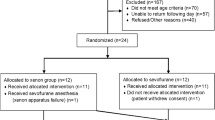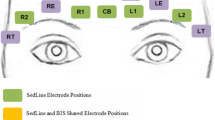Abstract
The BIS monitor (Aspect Medical Inc, Newton, USA) was the first electroencephalogram (EEG)-based monitor of the hypnotic effect reflected by a dimensionless figure ranging from 100 (awake state) to 0 (flat line EEG). Its widespread use makes it the most-studied and the best-known among same intended devices. Its algorithm processes low-frequency EEG oscillations in order to provide the Bispectral index. A BIS index ranging from 40 to 60 has been established as the proper for surgical performance. The BIS monitor permits a closer approach to the hypnotic component of anaesthesia beyond clinical signs and may reduce the probability of intraoperative awareness; therefore, it has become a recommended monitoring tool in routine practice. The SNAPTM monitor (Nicolet Biomedical, Madison WI, USA) is also intended for monitoring the hypnotic effect of anaesthetics, which is in turn displayed as an index ranging from 100 to 0, with 100 meaning a fully awake state and 0 meaning no brain activity. The algorithm of the SNAPTM monitor is featured by its additional processing of ultra-high EEG frequencies, which seem to be involved in the formation of consciousness. The use of these frequencies would theoretically improve responsiveness during increased brain activity. We studied its behaviour patterns and capability to monitor the hypnotic effect induced by sevoflurane-nitrous oxide by comparison with the BIS index. Seventy patients ASA I–III were induced with propofol, fentanyl and rocuronium, and maintained with sevoflurane-N2O. BIS and SNAP indices were simultaneously recorded before induction, after intubation, after incision, at the following 10, 30 and 50 minutes, awakening and extubation time points, together with heart rate and blood pressure. The Pearson correlation was R2 = 0.68 (p < .05). The Bland and Altman test showed a bias of 14.3 for SNAP index values with respect to BIS index values. We concluded that the SNAP index correlates with variations in the hypnotic effect induced by sevoflurane-nitrous oxide anaesthesia when compared with the BIS index. In this context, a SNAP index ranging from 58 to 70 would be equivalent to the BIS index range 40 to 60 and, therefore, the accurate for surgical performance.
Similar content being viewed by others
References
Johansen JW, Sebel PS. Development and clinical application of electroencephalographic bispectrum monitoring. Anesthesiology 2000; 93: 1336–1344.
Rampil IJ. A primer for EEG signal processing in anesthesia. Anesthesiology 1998; 89: 980-1002.
Martin-Larrauri R. Cómo se obtiene el BIS. Act Anest Rean (Madrid), 2001; 11(1): 24–28.
Sebel PS, Lang E, Rampil IJ, et al. A multicenter study of bispectral electroencephalogram analysis for monitoring anesthetic effect. Anesth Analg 1997; 84: 891–899.
Sleigh JW, Donovan J. Comparison of bispectral index, 95% spectral edge frequency and approximate entropy of the EEG, with changes in heart rate variability during induction of general anaesthesia. Br J Anaesth 1999; 82: 666–671.
Struys M, Versichelen L, Byttebier G, et al. Clinical usefulness of the bispectral index for titrating propofol target effect-site concentration. Anaesthesia 1998; 53: 4–12.
Johansen JW, Sebel PS, Sigl JC. Clinical impact of hypnotic-titration guidelines based on EEG bispectral index (BIS) monitoring during routine anesthetic care. J Clin Anesth 2000; 12: 433–443.
Heck M, Kumle B, Boldt J, et al. Electroencephalogram bispectral index predicts hemodynamic and arousal reactions during induction of anesthesia in patients undergoing cardiac surgery. J Cardiothorac Vasc Anesth 2000; 14: 693–697.
Iselin-Chaves IA, Flaishon R, Sebel PS, et al. The effect of the interaction of propofol an alfentanil on recall, loss of consciousness and the bispectral index. Anesth Analg 1998; 87: 949–955.
Ekman A, Lindholm M-L, Lennmarken C, Sandin R. Reduction in the incidence of awareness using BIS monitoring. Acta Anaesthesiol Scand 2004; 48: 20–26.
Myles PS, Leslie K, McNeil J, et al. Bispectral index monitoring to prevent awareness during anaesthesia: The B-aware randomised controlled trial. Lancet 2004; 363: 1757–1763.
O'Connor MF, Daves SM, Tung A, Cook RI, Thisted R, Apfelbaum J. BIS monitoring to prevent awareness during general anesthesia. Anesthesiology 2001; 94: 520–522.
Guignard B, Coste C, Menigaux C, Chauvin M. Reduced isoflurane consumption with bispectral index monitoring. Acta Anaesthesiol Scand 2001; 45: 308–314.
Gan TJ, Glass PS, Windsor A, Payne F, Rosow C, Sebel P, Manberg P. Bispectral index monitoring allows faster emergence and improved recovery from propofol, alfentanil and nitrous oxide anesthesia. BIS utility study group. Anesthesiology 1997; 87: 808–815.
Song D, Joshi GP, White PF. Titration of volatile agents using bispectral index facilitates recovery after ambulatory anesthesia. Anesthesiology 1997; 87: 842–848.
Yli-Hankala A, Vakkuri A, Annila P, Korttila K. EEG bispectral index monitoring in sevoflurane or porpofol anaesthesia: Analysis of direct costs and immediate recovery. Acta Anaesthesiol Scand 1999; 43: 545–549.
Pavlin DJ, Hong JY, Freund PR, Koerschgen ME, Bower JO, Bowdle TA. The effect of bispectral index monitoring on end-tidal gas concentration and recovery duration after outpatient anesthesia. Anesth Analg 2001; 93: 613–619.
Bannister CF, Brosius KK, Sigl JC, Meyer BJ, Sebel PS. The effect of bispectral index monitoring on anaesthetic use and recovery in children anesthetized with sevoflurane in nitrous oxide. Anesth Analg 2001; 92: 887–881.
Luginbühl M, Wüthrich S, Petersen-Felix A, Zbinden M, Schnider TM. Different benefit of bispectral index (BISTM) in desflurane and propofol anesthesia. Acta Anesthesiol Scand 2003; 47: 165–173.
Kreuer S, Bruhn J, Larsen R, Hoepstein M, Wilhelm W. Comparison of Alaris AEP index and bispectral index during propofol-remifentanil anaesthesia. Br J Anaesth 2003; 91: 336–340.
Barr G, Anderson RE, Jakobsson JG. A study of bispectral analysis and auditory evoked potential indices during propofol-induced hypnosis in volunteers: the effect of an episode of wakefulness on explicit memory. Anaesthesia 2001; 56: 888–893.
Lehmann A, Karzau J, Boldt J, Thaler E, Lang J, Isgro F. Bispectral index-guided anesthesia in patients undergoing aortocoronary bypass grafting. Anesth Analg 2003; 96: 336–343.
McDermott NB, VanSickle T, Motas D, Friesen R. Validation of the bispectral index monitor during conscious and deep sedation in children. Anesth Analg 2003; 97: 39–43.
Gajraj RJ, Doi M, Mantzaridis H, Kenny GNC. Comparison of bispectral EEG analysis and auditory evoked potentials for monitoring depth of anaesthesia during propofol anaesthesia. Br J Anaesth 1999; 82: 672–678.
Glass PS, Bloom M, Kearse L, et al. Bispectral index measures sedation and memory effects of propofol, midazolam, isoflurane and alfentanil in healthy patients volunteers. Anesthesiology 1997; 86: 836–847.
Blake DW, Hogg MN, Hackman CH, et al. Induction of anaesthesia with sevoflurane, preprogrammed propofol infusion or combined sevoflurane/propofol for laryngeal mask insertion: cardiovascular, movement and EEG Bispectral index response. Anaesth Intensive Care 1998; 26: 360–365.
Rampil IJ, Kim JS, Lehnhardt R, et al. Bispectral EEG index during nitrous oxide administration. Anesthesiology 1998 Sep; 89(3): 671–677.
Barr G, Jakobsson JG, Owall A, Anderson RE. Nitrous oxide does not alter bispectral index: Study with nitrous oxide as a sole agent and as an adjunct to i.v. anaesthesia. Br J Anaesth 1999 Jun; 82(6): 827–830.
Suzuki M, Edmonds HL, Tsueda K, et al. Effects of ketamne on bispectral index and levels of sedation. J Clin Monit Comput 1998 Jul; 14(5): 373.
Sandler NA. Additional clinical observations utilizing bispectral analysis. Anesth Prog 2000 Summer; 47(3); 84–86.
Traub RD, Kopell N, Bibbig A, et al. Gap junctions between interneuron dendrites can enhance synchrony of gamma oscillations in distributed networks. J Neurosci 2001; 21: 9478–9486.
Willman K, Springman S, Rusy D, Daily E. A preliminary evaluation of a new EEG index monitor in anesthetized patients. J Clin Monit Comp 2002; 17(6): 345–350.
Schmidt GN, Standl T, Lankenau G, et al. SNAP index and Bispectral index during induction of anaesthesia with propofol and remifentanil. Anasthesiol Intensivmed Notfal 2004; 39: 286–291.
Wong CA, Fragen RJ, Fitzgerald PC, McCarthy RJ. The association between propofol-induced loss of conciousness and the SNAP index. Anesth Analg 2005 Jan; 100(1): 141–148.
Schmidt GN, Bischoff P, Standl T, et al. SNAP index and Bispectral index during different states of propofol/remifentanil anaesthesia. Anaesthesia. 2005 Mar; 60(3): 228–234.
Olofsen E, Dahan A. The dynamic relationship between end-tidal sevoflurane and isoflurane concentrations and bispectral index and spectral edge frequency of the electroencephalogram. Anesthesiology 1999; 90: 1345–1353.
Bruhn J, Bouillon T, Schafer SL. Bispectral index (BIS) and burst suppression: revealing a part of the BIS algorithm. J Clin Monit Comp 2000; 16: 593–596.
Bruhn J, Bouillon TW, Schafer SL. Onset of propofol-induced burst suppression may be correctly detected as deepening of anaesthesia by approximate entropy but not by bispectral index. Br J Anaesth 2001 Sep; 87 (3): 505–507.
Wong CA, Fitzgerald PC, McCarthy RJ. Comparison of depth of anesthesia indices (SNAPTM vs Bispectral) during balanced general anesthesia in patients undergoing outpatient gynaecologic surgery. [abstract A553]. 2002 ASA meeting Abstracts. Available at: http://asa-abstracts.com.
Paloheimo M. Quantitative surface electromyography (qEMG): applications in anaesthesiology and critical care. Acta Anaesthesiol Scand Suppl 1990; 93: 1–83.
Vivien B, Di Maria S, Outtara A, et al. Overestimation of Bispectral index in sedated intensive care unit patients revealed by administration of muscle relaxant. Anesthesiology 2003 Mar; 94(3): 604–608.
Messner M, Beese U, Romstock J, et al. The Bispectral index declines during neuromuscular block in fully awake persons. Anesth Analg 2003 Aug; 97(2): 488–491.
Greif R, Greenwald S, Schweitzer E, et al. Muscle relaxation does not alter hypnotic level during propofol anesthesia. Anesth Analg 2002 Mar; 94(3): 604–608.
Kearse LA Jr, Rosow C, Zaslavsky A, et al. Bispectral analysis of the electroencephalogram predicts conscious processing of information during propofol sedation and hypnosis. Anesthesiology 1998 Jan; 88(1): 25–34.
Author information
Authors and Affiliations
Corresponding author
Additional information
Preliminary results presented at the 13th World Congress of Anesthesiologists, Paris, France on April 17–23 and at Euroanaesthesia 2004, Lisbon, Portugal on June 5th–8th
Rights and permissions
About this article
Cite this article
Ruiz-Gimeno, P., Soro, M., Pérez-Solaz, A. et al. Comparison of the Eeg-Based SnapTM Index and the Bispectral (BisTM) Index During Sevoflurane - Nitrous Oxide Anaesthesia. J Clin Monit Comput 19, 383–389 (2005). https://doi.org/10.1007/s10877-005-5871-4
Received:
Accepted:
Published:
Issue Date:
DOI: https://doi.org/10.1007/s10877-005-5871-4




